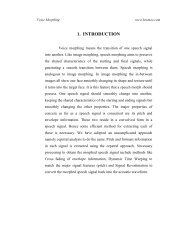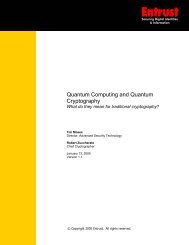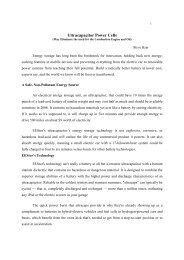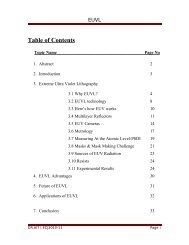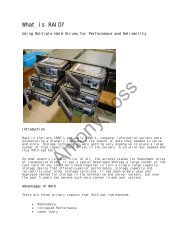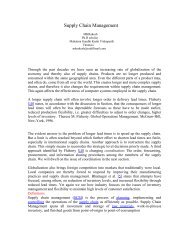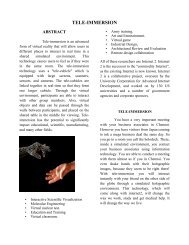You also want an ePaper? Increase the reach of your titles
YUMPU automatically turns print PDFs into web optimized ePapers that Google loves.
<strong>Cell</strong> Phone <strong>Jammer</strong>s<br />
Seminar Report’ 06<br />
ACKNOWLEDGEMENT<br />
I express my sincere gratitude to Mr.Shiju P.P,Head of Department for<br />
rendering me all facilities and guiding me right through the end for the successful<br />
completion and presentation of the seminar.<br />
I also express my gratitude to my seminar guide Mr. Rajesh Kumar lecturer<br />
ECE Department for the support and encouragement given for the successful<br />
completion and presentation of the seminar.<br />
I am also obliged to the faculty of ECE Department for having given me their<br />
timely suggestions in my venture.<br />
I would also want to express my sincere thanks to my friends for the help<br />
extended by them.<br />
Dept of ECE<br />
LBSCE, Kasaragod<br />
1
<strong>Cell</strong> Phone <strong>Jammer</strong>s<br />
Seminar Report’ 06<br />
ABSTRACT<br />
Radiation in cell phones is generated in the transmitter and emitted through<br />
the antenna. <strong>Cell</strong> phones have low-power transmitters in them.<br />
The radio waves that send the encoded signal are made up of electromagnetic<br />
radiation propagated by the antenna. A cell phone works by communicating with its<br />
service network through a cell tower or base station. <strong>Cell</strong> towers divide a city into<br />
small areas, or cells. As a cell-phone user drives down the street, the signal is handed<br />
from tower to tower.<br />
Technology that blocks cellular signals could impose etiquette in public.<br />
Little book-sized devices called cell jammers may be as ubiquitous as cells some day.<br />
The jammers emit low-level radiofrequencies that thwart mobile phone signals within<br />
a pre-set radius, making a cell out of network reach for the cell-user. The most<br />
successful range of jammers are manufactured in Israel, the U.S. and the U.K. and<br />
cost around Rs. 2 lakhs each or more.<br />
<strong>Jammer</strong>s work in one of two ways. Some devices set their signal to the same<br />
frequency as pagers and mobile phones, cutting off communication between handsets<br />
and base stations. Others work as electronic filters that fool mobile phones into<br />
thinking there are no frequencies available to make or receive calls.<br />
Jamming devices overpower the cell phone by transmitting a signal on the<br />
same frequency and at a high enough power that the two signals collide and cancel<br />
each other out. <strong>Cell</strong> phones are designed to add power if they experience low-level<br />
Dept of ECE<br />
LBSCE, Kasaragod<br />
2
<strong>Cell</strong> Phone <strong>Jammer</strong>s<br />
Seminar Report’ 06<br />
interference, so the jammer must recognize and match the power increase from the<br />
phone.<br />
CONTENTS<br />
1. INTRODUCTION 01<br />
2. INSIDE A CELL PHONE 02<br />
3. SOURCE OF RADIATION 06<br />
4. WHY TO USE JAMMER 08<br />
5. JAMMING BASICS 09<br />
6. HOW IT WORKS 10<br />
7. INSIDE A CELL-PHONE JAMMER 12<br />
8. BLOCK DIAGRAM 14<br />
9. WORKING 15<br />
10. SPECIMEN OF CELL-PHONE JAMMERS 16<br />
11. LIMITATIONS 19<br />
12. CONCLUSION 20<br />
13. REFERENCE 21<br />
Dept of ECE<br />
LBSCE, Kasaragod<br />
3
<strong>Cell</strong> Phone <strong>Jammer</strong>s<br />
Seminar Report’ 06<br />
.<br />
INTRODUCTION<br />
<strong>Cell</strong> phone jamming devices were originally developed for law enforcement<br />
and the military to interrupt communications by criminals and terrorist .The bombs<br />
that blew up commuter trains in Spain in march 2004,as well as blast in Bali in<br />
October 2002,all relied on cell phones to trigger explosives. It has been widely<br />
reported that a cell phone jammer thwarted an assassination attempt on Pakistani<br />
President Musharraff in December 2003<br />
During hostage situation police can control when and where a capture can<br />
make a call. Police can block calls during drug raid so suspects can’t communicate<br />
outside area .Corporations use jammers to stop corporate espionage by blocking<br />
voice transmissions and photo transmissions from camera phones<br />
Dept of ECE<br />
LBSCE, Kasaragod<br />
4
<strong>Cell</strong> Phone <strong>Jammer</strong>s<br />
Seminar Report’ 06<br />
INSIDE A CELL PHONE<br />
On a "complexity per cubic inch" scale, cell phones are some of the most<br />
intricate devices people use on a daily basis. Modern digital cell phones can process<br />
millions of calculations per second in order to compress and decompress the voice<br />
stream.<br />
If you take a cell phone apart, you find that it contains just a few individual parts:<br />
• An amazing circuit board containing the brains of the phone<br />
• An antenna<br />
• A liquid crystal display (LCD)<br />
Dept of ECE<br />
LBSCE, Kasaragod<br />
5
<strong>Cell</strong> Phone <strong>Jammer</strong>s<br />
Seminar Report’ 06<br />
• A keyboard (not unlike the one you find in a TV remote control)<br />
• A microphone<br />
• A speaker<br />
• A battery<br />
The circuit board is the heart of the system. Here is one from a typical Nokia digital<br />
phone:<br />
The front and back of the circuit board<br />
In the photos above, you see several computer chips. Let's talk about what<br />
some of the individual chips do. The analog-to-digital and digital-to-analog<br />
conversion chips translate the outgoing audio signal from analog to digital and the<br />
incoming signal from digital back to analog. The digital signal processor (DSP) is<br />
Dept of ECE<br />
LBSCE, Kasaragod<br />
6
<strong>Cell</strong> Phone <strong>Jammer</strong>s<br />
Seminar Report’ 06<br />
a highly customized processor designed to perform signal-manipulation calculations<br />
at high speed.<br />
The microprocessor handles all of the housekeeping chores for the keyboard<br />
and display, deals with command and control signaling with the base station and<br />
also coordinates the rest of the functions on the board.<br />
The microprocessor<br />
The ROM and Flash memory chips provide storage for the phone's operating<br />
system and customizable features, such as the phone directory. The radio frequency<br />
(RF) and power section handles power management and recharging, and also deals<br />
with the hundreds of FM channels. Finally, the RF amplifiers handle signals<br />
traveling to and from the antenna<br />
Transmission<br />
Dept of ECE<br />
LBSCE, Kasaragod<br />
7
<strong>Cell</strong> Phone <strong>Jammer</strong>s<br />
Seminar Report’ 06<br />
<strong>Cell</strong> phones have low-power transmitters in them. Many cell phones have<br />
two signal strengths: 0.6 watts and 3 watts (for comparison, most CB radios transmit<br />
at 4 watts). The base station is also transmitting at low power. Low-power<br />
transmitters have two advantages:<br />
• The transmissions of a base station and the phones within its cell do not<br />
make it very far outside that cell. Therefore, in the figure above, both of the<br />
purple cells can reuse the same 56 frequencies. The same frequencies can<br />
be reused extensively across the city.<br />
• The power consumption of the cell phone, which is normally<br />
batteryoperated, is relatively low. Low power means small batteries, and this<br />
is what has made handheld cellular phones possible. The cellular approach<br />
requires a large number of base stations in a city of any size.<br />
A typical large city can have hundreds of towers. But because so many people<br />
are using cell phones, costs remain low per user. Each carrier in each city also<br />
runs one central office called the Mobile Telephone Switching Office<br />
(MTSO). This office handles all of the phone connections to the normal land-<br />
based phone system, and controls all of the base stations in the region.<br />
Dept of ECE<br />
LBSCE, Kasaragod<br />
8
<strong>Cell</strong> Phone <strong>Jammer</strong>s<br />
Seminar Report’ 06<br />
SOURCE OF RADIATION<br />
Electromagnetic radiation is made up of waves of electric and magnetic<br />
energy moving at the speed of light, according to the Federal Communications<br />
Commission (FCC). All electromagnetic energy falls somewhere on the<br />
electromagnetic spectrum, which ranges from extremely low frequency (ELF)<br />
radiation to X-rays and gamma rays.<br />
When talking on a cell phone, a transmitter takes the sound of your voice and<br />
encodes it onto a continuous sine wave. A sine wave is just a type of continuously<br />
varying wave that radiates out from the antenna and fluctuates evenly through space.<br />
Sine waves are measured in terms of frequency, which is the number of times a<br />
Dept of ECE<br />
LBSCE, Kasaragod<br />
9
<strong>Cell</strong> Phone <strong>Jammer</strong>s<br />
Seminar Report’ 06<br />
wave oscillates up and down per second. Once the encoded sound has been placed<br />
on the sine wave, the transmitter sends the signal to the antenna, which then sends<br />
the signal out.<br />
Radiation in cell phones is generated in the transmitter and emitted through the<br />
antenna.<br />
<strong>Cell</strong> phones have low-power transmitters in them. A handheld cell phone<br />
operates on about 0.75 to 1 watt of power. The position of a transmitter inside a<br />
phone varies depending on the manufacturer, but it is usually in close proximity to<br />
the phone's antenna. The radio waves that send the encoded signal are made up of<br />
Dept of ECE<br />
LBSCE, Kasaragod<br />
10
<strong>Cell</strong> Phone <strong>Jammer</strong>s<br />
Seminar Report’ 06<br />
electromagnetic radiation propagated by the antenna. The function of an antenna<br />
in any radio transmitter is to launch the radio waves into space; in the case of cell<br />
phones, these waves are picked up by a receiver in the cell-phone tower.<br />
WHY TO USE JAMMER<br />
<strong>Cell</strong> phones are everywhere these days. According to the <strong>Cell</strong>ular<br />
Telecommunications and Internet Association, almost 195 million people in the<br />
United States had cell-phone service in October 2005. And cell phones are even<br />
more ubiquitous in Europe.<br />
It's great to be able to call anyone at anytime. Unfortunately, restaurants,<br />
movie theaters, concerts, shopping malls and churches all suffer from the spread of<br />
cell phones because not all cell-phone users know when to stop talking. It is also<br />
observed that teenagers where cheeting on exams by sending text messages or<br />
taking pictures of tests .in such circumstances cell phones have become<br />
disturbance .So it is important to avoid cell phones <strong>Cell</strong> jammers are employed in<br />
places where silence is preffered, like religious places, exam halls and libraries<br />
While most of us just grumble and move on, some people are actually going<br />
to extremes to retaliate. <strong>Cell</strong> phones are basically handheld two-way radios. And<br />
like any radio, the signal can be disrupted, or jammed.<br />
Dept of ECE<br />
LBSCE, Kasaragod<br />
11
<strong>Cell</strong> Phone <strong>Jammer</strong>s<br />
Seminar Report’ 06<br />
JAMMING BASICS<br />
Disrupting a cell phone is the same as jamming any other type of radio<br />
communication. A cell phone works by communicating with its service network<br />
through a cell tower or base station. <strong>Cell</strong> towers divide a city into small areas, or<br />
cells.<br />
to tower.<br />
As a cell-phone user drives down the street, the signal is handed from tower<br />
A jamming device transmits on the same radio frequencies as the cell phone,<br />
disrupting the communication between the phone and the cell-phone base station in<br />
the tower.<br />
Dept of ECE<br />
LBSCE, Kasaragod<br />
12
<strong>Cell</strong> Phone <strong>Jammer</strong>s<br />
Seminar Report’ 06<br />
It's a called a denial-of-service attack. The jammer denies service of the<br />
radio spectrum to the cell-phone users within range of the jamming device.<br />
HOW IT WORKS<br />
Jamming devices overpower the cell phone by transmitting a signal on the<br />
same frequency and at a high enough power that the two signals collide and cancel<br />
each other out. <strong>Cell</strong> phones are designed to add power if they experience low-level<br />
interference, so the jammer must recognize and match the power increase from the<br />
phone.<br />
<strong>Cell</strong> phones are full-duplex devices , which means they use two separate<br />
frequencies, for talking and one for listening simultaneously. Some jammers block<br />
only one of the frequencies used by cell phones, which has the effect of blocking<br />
Dept of ECE<br />
LBSCE, Kasaragod<br />
13
<strong>Cell</strong> Phone <strong>Jammer</strong>s<br />
Seminar Report’ 06<br />
both. The phone is tricked into thinking there is no service because it can receive<br />
only one of the frequencies.<br />
Less complex devices block only one group of frequencies, while<br />
sophisticated jammers can block several types of networks at once to head off dual-<br />
mode or trimode phones that automatically switch among different network types to<br />
find an open signal.<br />
Some of the high-end devices block all frequencies at once, and others can be<br />
tuned to specific frequencies.<br />
To jam a cell phone, all you need is a device that broadcasts on the correct<br />
frequencies. Although different cellular systems process signals differently, all<br />
cellphone networks use radio signals that can be interrupted. GSM, used in digital<br />
cellular and PCS-based systems, operates in the 900-MHz and 1800-MHz bands in<br />
Europe and Asia and in the 1900-MHz (sometimes referred to as 1.9-GHz) band in<br />
the United States. <strong>Jammer</strong>s can broadcast on any frequency and are effective against<br />
AMPS, CDMA, TDMA, GSM, PCS, DCS, iDEN and Nextel systems. Oldfashioned<br />
analog cell phones and today's digital devices are equally susceptible to jamming.<br />
Dept of ECE<br />
LBSCE, Kasaragod<br />
Network before jamming Network after jamming<br />
14
<strong>Cell</strong> Phone <strong>Jammer</strong>s<br />
Seminar Report’ 06<br />
Dept of ECE<br />
LBSCE, Kasaragod<br />
INSIDE A CELL-PHONE JAMMER<br />
Photo courtesy Netline Communications<br />
Technologies (NCT) Ltd.<br />
<strong>Cell</strong>-phone jammer<br />
15
<strong>Cell</strong> Phone <strong>Jammer</strong>s<br />
Seminar Report’ 06<br />
Electronically speaking, cell-phone jammers are very basic devices. The<br />
simplest just have an on/off switch and a light that indicates it's on. More complex<br />
devices have switches to activate jamming at different frequencies. Components of a<br />
jammer include:<br />
Antenna<br />
Every jamming device has an antenna to send the signal. Some are contained<br />
ithin an electrical cabinet. On stronger devices, antennas are external to provide<br />
longer range and may be tuned for individual frequencies.<br />
Circuitry<br />
The main electronic components of a jammer are:<br />
• Voltage-controlled oscillator - Generates the radio signal that will interfere<br />
with the cell phone signal<br />
• Tuning circuit - Controls the frequency at which the jammer broadcasts its<br />
signal by sending a particular voltage to the oscillator .<br />
• Noise generator - Produces random electronic output in a specified<br />
frequency range to jam the cell-phone network signal (part of the tuning<br />
circuit).<br />
• RF amplification (gain stage) - Boosts the power of the radio frequency<br />
output to high enough levels to jam a signal .<br />
Dept of ECE<br />
LBSCE, Kasaragod<br />
16
<strong>Cell</strong> Phone <strong>Jammer</strong>s<br />
Seminar Report’ 06<br />
Power supply<br />
Smaller jamming devices are battery operated. Some look like cell phone and<br />
use cell-phone batteries. Stronger devices can be plugged into a standard outlet or<br />
wired into a vehicle's electrical system.<br />
Dept of ECE<br />
LBSCE, Kasaragod<br />
BLOCK DIAGRAM<br />
17
<strong>Cell</strong> Phone <strong>Jammer</strong>s<br />
Seminar Report’ 06<br />
Dept of ECE<br />
LBSCE, Kasaragod<br />
WORKING<br />
18
<strong>Cell</strong> Phone <strong>Jammer</strong>s<br />
Seminar Report’ 06<br />
Noise generator produces random electronic output in a specified<br />
frequency range to jam the cell-phone network signal (part of the tuning<br />
circuit).This output is given as input for the phase detector and VCO the output is<br />
also given as another input. The phase detector compares the input frequency with<br />
VCO frequency and generates a dc voltage . this dc voltage proportional to the<br />
phase difference between the two input frequencies .This voltage is often reffered<br />
to as error voltage. The output of phase detector is applied to the low pass filter,<br />
which removes the high frequency noise and produce dc level. This dc level, in<br />
turn, is the input to the voltage controlled oscillator (VCO).The VCO frequency is<br />
compared with the input frequencies and adjusted until it is equal to the input<br />
frequencies .VCO output is radio signal that will interfere with the cell phone<br />
signal. This is given to RF power amplifier stage to- boost the power of the radio<br />
frequency output to high enough levels to jam a signal .<br />
Dept of ECE<br />
LBSCE, Kasaragod<br />
SPECIMEN OF CELL-PHONE JAMMERS<br />
19
<strong>Cell</strong> Phone <strong>Jammer</strong>s<br />
Seminar Report’ 06<br />
• What is <strong>Cell</strong>ular phone-call Blocker?<br />
This is an instrument to stop using cellular phone by shielding the electric-wave<br />
from base station.<br />
• Specifications<br />
Dept of ECE<br />
LBSCE, Kasaragod<br />
20
<strong>Cell</strong> Phone <strong>Jammer</strong>s<br />
Seminar Report’ 06<br />
Dept of ECE<br />
LBSCE, Kasaragod<br />
21
<strong>Cell</strong> Phone <strong>Jammer</strong>s<br />
Seminar Report’ 06<br />
SH066 GSM CELL PHONE JAMMER<br />
A new GSM cell phone jammer, the SH066 that is designed to look like<br />
another cell phone has been launched. The jammer has an output power of about<br />
20mW and an effective range of up to 10 – 15 meters radius in optimum conditions,<br />
depending on the type and location of cellular system.<br />
Dept of ECE<br />
LBSCE, Kasaragod<br />
22
<strong>Cell</strong> Phone <strong>Jammer</strong>s<br />
Seminar Report’ 06<br />
LIMITATIONS<br />
Jamming is seen as property theft, because a private company has purchased<br />
the rights to the radio spectrum , and jamming the spectrum is akin to stealing the<br />
property the company has purchased. It also represents a safety hazard because<br />
jamming a signal could block the call of a babysitter frantically trying to contact a<br />
parent or a someone trying to call for an ambulance.<br />
However, in some “high risk” areas, such as hospitals where mobile phone<br />
interferes with medical equipment, jamming technology, which creates radiation of its<br />
own, intensifies the problem<br />
Dept of ECE<br />
LBSCE, Kasaragod<br />
23
<strong>Cell</strong> Phone <strong>Jammer</strong>s<br />
Seminar Report’ 06<br />
CONCLUSION<br />
While the law clearly prohibits using a device to actively disrupt a cell-phone<br />
signal, there are no rules against passive cell-phone blocking. Companies are working<br />
on devices that control a cell phone but do not "jam the signal." One device sends<br />
incoming calls to voicemail and blocks outgoing calls. The argument is that the phone<br />
still works, so it is technically not being jammed.<br />
<strong>Cell</strong>-phone alerters are available that indicate the presence of a cell-phone<br />
signal. These have been used in hospitals where cell-phone signals could interfere<br />
with sensitive medical equipment. When a signal is detected, users are asked to turn<br />
off their phones.<br />
In most of the countries, it is illegal for private citizens to jam cell phone<br />
transmission, but some countries are allowing business and government<br />
organizations to install jammers in areas where cell phones use is seen as a public<br />
nuisance. The leaders of India's parliament revealed they had already installed the<br />
devices to avoid interruptions during sessions.<br />
However, in some “high risk” areas, such as hospitals where mobile phone<br />
interferes with medical equipment, jamming technology, which creates radiation of its<br />
own, intensifies the problem<br />
Dept of ECE<br />
LBSCE, Kasaragod<br />
24
<strong>Cell</strong> Phone <strong>Jammer</strong>s<br />
Seminar Report’ 06<br />
• www.howstuffworks.com<br />
• www.globalgadgetuk.com<br />
• www.vlsibank.com<br />
• www.bsnl.in<br />
• www.cellular.co.za<br />
• www.techtv.com<br />
• www.zdnet.com.au<br />
• www.google.com<br />
Dept of ECE<br />
LBSCE, Kasaragod<br />
REFERENCE<br />
25



